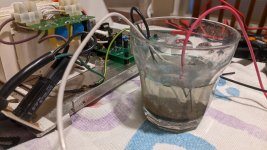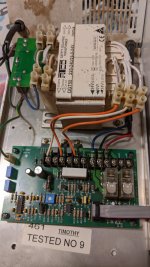I am hoping there is some knowledge about this older SWG marketed under the Clearwater/Zodiak/Jandy LM2-40/24/16 labels. It is probably 10-14 years old.
I bought this item: Zodiac Clearwater LM2-40 Power Center on craigslist a few days ago, it did NOT include a salt cell. The owner said it worked up until his last salt cell failed, at which time he bought a latest generation salt generator/cell. I trust him, and after taking it apart and looking inside, everything looks good.
But I still want to test it before spending ~$400 for an OEM salt cell shipped from Australia, haha. There is at least one barrier to doing the testing, and that is that the salt cell has a built- flow detector (seems to only rely on electrical characteristics in the cell) that will disable the voltage out of the Power Center to the salt cell (and my testing of it) if I can’t figure out what is necessary to “trigger” this sensor.
The “sensor” outputs a single electrical probe from the cell, so I suspect that there is some voltage generation/sensing between the salt cell +/- electrical feeds AND this probe. For some reason, I don’t think its mechanical but without having a cell to look at, it is tough to tell for sure.
Does anyone have experience with this older SWG? And/or possibly have an idea about how to generate a “pretend flow” in order to test the voltages to the cell. I also want to investigate a bit about its current reversing capability because the way it is described (almost like a “cleaning”), it seems like it might NOT be what is done on more recent SWGs where current is reversed every X amount of time.
Thanks...
Zodiak LM Series Professional Installation Manual & Owners Manual
Work Pro LM-2 Installation manual | Manualzz
Zodiak Clearwater Trouble Shooting Guide:
https://images.inyopools.com/cloud/documents/cw-lm2-manual-english.pdf
I bought this item: Zodiac Clearwater LM2-40 Power Center on craigslist a few days ago, it did NOT include a salt cell. The owner said it worked up until his last salt cell failed, at which time he bought a latest generation salt generator/cell. I trust him, and after taking it apart and looking inside, everything looks good.
But I still want to test it before spending ~$400 for an OEM salt cell shipped from Australia, haha. There is at least one barrier to doing the testing, and that is that the salt cell has a built- flow detector (seems to only rely on electrical characteristics in the cell) that will disable the voltage out of the Power Center to the salt cell (and my testing of it) if I can’t figure out what is necessary to “trigger” this sensor.
The “sensor” outputs a single electrical probe from the cell, so I suspect that there is some voltage generation/sensing between the salt cell +/- electrical feeds AND this probe. For some reason, I don’t think its mechanical but without having a cell to look at, it is tough to tell for sure.
Does anyone have experience with this older SWG? And/or possibly have an idea about how to generate a “pretend flow” in order to test the voltages to the cell. I also want to investigate a bit about its current reversing capability because the way it is described (almost like a “cleaning”), it seems like it might NOT be what is done on more recent SWGs where current is reversed every X amount of time.
Thanks...
Zodiak LM Series Professional Installation Manual & Owners Manual
Work Pro LM-2 Installation manual | Manualzz
Zodiak Clearwater Trouble Shooting Guide:
https://images.inyopools.com/cloud/documents/cw-lm2-manual-english.pdf



